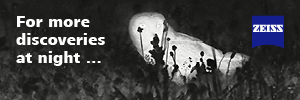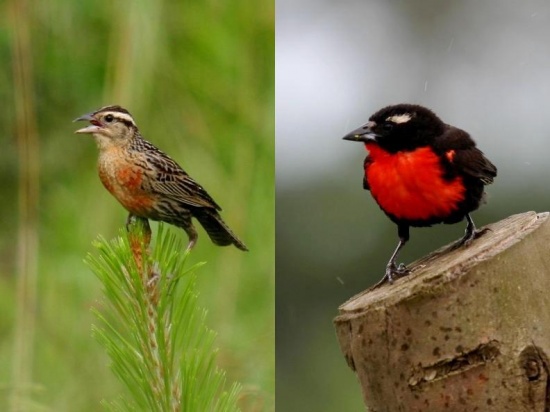(Attempt to disguise copied text. Picture of juvenile male. Additional GSearch to allow for extra scientific name. References) |
(genus change (IOC and H&M)) |
||
| Line 1: | Line 1: | ||
'''Aternative names: Bonaparte's Blackbird; White-browed Meadowlark''' | '''Aternative names: Bonaparte's Blackbird; White-browed Meadowlark''' | ||
[[Image:White-browed_Blackbird.jpg|thumb|550px|right|Photo by {{user|Jamfaraco|Jamfaraco}}<br />[[Brazil]]]] | [[Image:White-browed_Blackbird.jpg|thumb|550px|right|Photo by {{user|Jamfaraco|Jamfaraco}}<br />[[Brazil]]]] | ||
| − | ;[[:Category: | + | ;[[:Category:Leistes|Leistes]] superciliaris |
| − | '' | + | ''Sturnella superciliaris'' |
==Identification== | ==Identification== | ||
Male 17·8 cm (7 in), Female 17 cm (6¾ in) | Male 17·8 cm (7 in), Female 17 cm (6¾ in) | ||
| Line 19: | Line 19: | ||
This is a [[Dictionary_M-O#M|monotypic]] species<sup>[[#References|[1]]]</sup>. | This is a [[Dictionary_M-O#M|monotypic]] species<sup>[[#References|[1]]]</sup>. | ||
| − | This taxon has sometimes been considered a subspecies of [[Red-breasted Blackbird]] (''Sturnella militaris''). | + | This taxon has sometimes been considered a subspecies of [[Red-breasted Blackbird]] (''Sturnella militaris'').<br /> |
| − | + | Clements places this species in the genus ''[[: Category:Sturnella|Sturnella]]''.<br /> | |
==Habitat== | ==Habitat== | ||
Commonly seen in agricultural fields, wet meadows and damp grassland. They like areas with the odd bush or fence post for males to use as a song post. | Commonly seen in agricultural fields, wet meadows and damp grassland. They like areas with the odd bush or fence post for males to use as a song post. | ||
| Line 40: | Line 40: | ||
{{GSearch|Leistes+superciliaris Use "Leistes superciliaris" to}} | {{GSearch|Leistes+superciliaris Use "Leistes superciliaris" to}} | ||
| − | [[Category:Birds]][[Category: | + | [[Category:Birds]][[Category:Leistes]] |
Revision as of 19:25, 11 February 2018
Aternative names: Bonaparte's Blackbird; White-browed Meadowlark
- Leistes superciliaris
Sturnella superciliaris
Identification
Male 17·8 cm (7 in), Female 17 cm (6¾ in)
- Black overall plumage
- Red throat, belly and wing epaulettes
- White supercilium
Female
- Buff edged dark brown upperpart feathers
- Yellowish-brown underparts
- Pale streaks through the crown and eye
Juvenile resembles female paler.
Distribution
South America: found from extreme south-eastern Peru to Paraguay, Uruguay, northern Argentina and Brazil; always south of the Amazon basin.
Taxonomy
This is a monotypic species[1].
This taxon has sometimes been considered a subspecies of Red-breasted Blackbird (Sturnella militaris).
Clements places this species in the genus Sturnella.
Habitat
Commonly seen in agricultural fields, wet meadows and damp grassland. They like areas with the odd bush or fence post for males to use as a song post.
Behaviour
Breeding
They build grass-lined deep open cup nest which is placed on the ground in tall grass. Generally they nest in loose colonies. The clutch consists of 3-5 greenish eggs with reddish-brown-blotches.
This species is often parasitised by the Shiny Cowbird.
Diet
Their diet consists mostly of arthropods, supplementd with the seeds, insects and spiders.
References
- Clements, J. F., T. S. Schulenberg, M. J. Iliff, D. Roberson, T. A. Fredericks, B. L. Sullivan, and C. L. Wood. 2015. The eBird/Clements checklist of birds of the world: v2015, with updates to August 2015. Downloaded from http://www.birds.cornell.edu/clementschecklist/download/
- Handbook of the Birds of the World Alive (retrieved February 2016)
- Wikipedia
- BF Member observations
Recommended Citation
- BirdForum Opus contributors. (2024) White-browed Blackbird. In: BirdForum, the forum for wild birds and birding. Retrieved 15 May 2024 from https://www.birdforum.net/opus/White-browed_Blackbird
External Links





